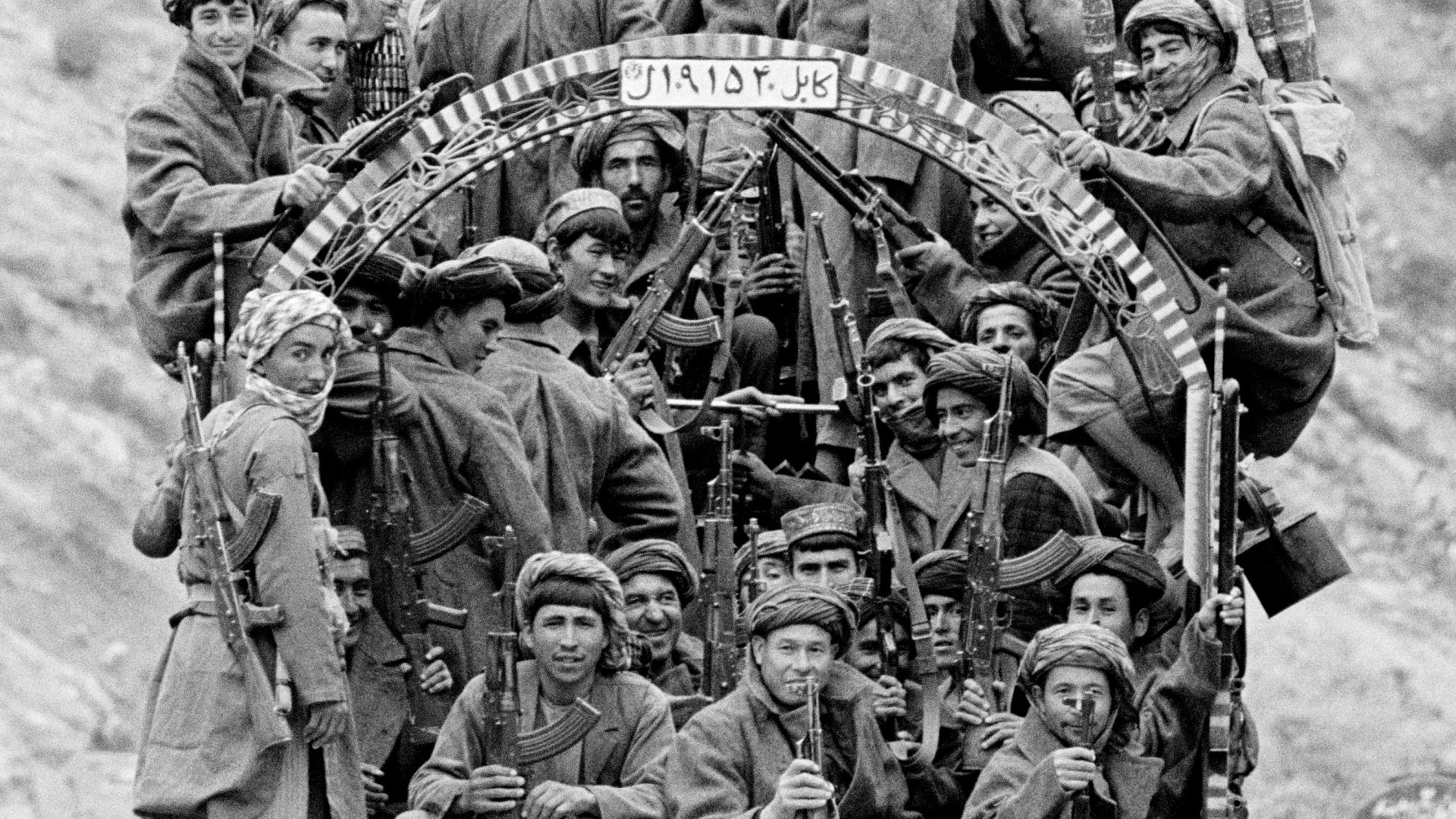Afghans sit inside a U.S. military aircraft to leave Afghanistan, at the military airport in Kabul, on August 19, 2021 after Taliban's military takeover. (Photo by SHAKIB RAHMANI/AFP via Getty Images)
Thousands of people are desperate to flee Afghanistan as the Taliban secures its stronghold over the country, but evacuations are chaotic and confusing—and those helping people secure visas and passports are “at capacity.”“Right now there are no rules,” said VOA News war correspondent Ayesha Tanzeem, who landed in Islamabad from Kabul on Friday. She later clarified that the rules in place are unclear. There have been Afghans who’ve been rejected from getting on planes because they don’t have documents, while others have managed to get onto flights and flee without them, Tanzeem said.“During the first two days anyone who could be put on a plane was put on a plane,” Tanzeem said, adding she’s spoken with people who’ve lost their families at the airport. She also said she’s seen babies wailing, women panicking, and men breaking down into tears. Others have been camping out at the airport all week. The crowds are so bad it took Tanzeem three attempts to get to the airport and onto a plane, before she could depart. “The chaos was so much,” she said.Several countries have said they’d welcome thousands of Afghans seeking asylum, and US, German, Dutch, Canadian, and French flights carrying evacuees have flown out of Kabul’s Hamid Karzai airport this week. The efforts come as the Taliban, a fundamentalist militant group known for imposing strict interpretations of Islam, take over Afghanistan following the departure of US troops.In a news conference on Friday, US President Joe Biden said the US has secured the Kabul airport and 13,000 people have been evacuated since August 14. The evacuation mission is “one of the largest, most difficult airlifts in history,” he said.  Biden pledged to evacuate all US citizens and many Afghans who helped the US during its mission in Afghanistan, such as translators and interpreters. He also said the US will help evacuate Afghans at risk of being targeted, including women leaders, journalists, and advocacy groups. “We are going to do everything—everything—we can to provide safe evacuation for allies, partners, and Afghans who might be targeted because of their association with the US,” he said.But Afghans and advocates say people on the ground are struggling to apply for amnesty because countries don’t have streamlined processes in place to help. There are backlogs for visa and passport applications—which were worsened by the COVID-19 pandemic—while some others, including non-governmental organizations that are trying to secure travel documents for people, say they’re “at capacity,” Tanzeem said.According to Tanzeem, the lack of coordination between countries isn’t helping.“Europeans started to cooperate, but then there is the US, there are the Canadians, one side of the airport is guarded by the Turks, and it’s not really organized among them. It’s confusing,” Tanzeem said. Despite the fact that thousands upon thousands of Afghans want out, countries are limiting how many people they’re willing to take. On Thursday, Canadian Prime Minister Justin Trudeau told Canadians that it’ll be “nearly impossible” to get as many Afghans out of the country as initially hoped because the Taliban is blocking access for Afghans who want to leave the country. “Unless the Taliban shift their posture significantly, which is something the international community and Canada are working on, it is going to be very, very difficult to get many people out,” Trudeau said. “We will get some, certainly, but to get many people out, as many as we’d want, is going to be almost impossible in the coming weeks.”Trudeau pledged to welcome 20,000 Afghans, but it’s worth noting that many of those may already be out of Afghanistan, waiting at refugee camps or third countries, for instance. Hila Taraky, a lawyer based in Ontario, Canada, and her family escaped the Taliban in 1998, when Taraky was four, while her brother and sister were 2 and under 1, respectively. It shouldn’t come as a surprise, then, that Afghans and the Afghan diaspora are watching fearfully, even as the Taliban says it won’t seek revenge.“My dad had one of us under one arm, the other under one, and was just booking it, running,” Taraky said. “We were looking back and there was smoke coming to get us. That is what they escaped. They were hiding our eyes as we walked by dead people.”“A regime that did that is now claiming legitimacy and it is completely frightening—it scares us to the bone,” Taraky said.One of Taraky’s uncles learned the Taliban reclaimed control after recovering from COVID-19. As soon as he found out, he had a stroke and died, she said. Tanzeem called the widespread distrust against the Taliban a “trust deficit.” People worry that right now the Taliban are too busy trying to negotiate a transfer of power, but “once they settle, they’ll impose rules on women,” among other restrictions, she said. The Taliban controlled Afghanistan from 1996 to 2001, until U.S.-backed forces overthrew the regime. At the time, the Taliban barred women from public life, including attending school, and banned music, movies, and television. The group has been accused of a number of human rights abuses, including violent punishment of dissidents—beheadings and chopping off hands—and treating young women and girls as sex slaves. It’s unknown yet how the group will rule, but reports show that violence and intimidation are escalating. Taliban officers already killed a journalist’s relative while going door-to-door, and in some provinces, there have been reports of Taliban officers taking women from their homes. Many Afghans are currently hiding at home.Taraky told VICE World News she and her family are in touch with people on the ground and they’re trying to help people evacuate. The problem is that Canada’s plan to relocate Afghans is so confusing and bureaucratic, they don’t know how to offer their friends and family guidance or direction, she said.During a joint press conference between Human Rights Watch and Afghanistan International Human Rights Commission, advocates said the same thing of the U.S. There have been many promises to get Americans out of the country, followed by Afghan nationals who supported the US and at-risk Afghans, including activists, women’s rights advocates, and LGBTQ folks. “There will not be enough space unless there is better coordination,” said John Sifton, the Asia advocacy director with Human Rights Watch.It’s hard to say exactly how many people are yet to be evacuated. It’s unknown, for instance, how many U.S. citizens are in Afghanistan, Biden said, while the Canadian government refused to release numbers.Follow Anya Zoledziowski on Twitter.
Biden pledged to evacuate all US citizens and many Afghans who helped the US during its mission in Afghanistan, such as translators and interpreters. He also said the US will help evacuate Afghans at risk of being targeted, including women leaders, journalists, and advocacy groups. “We are going to do everything—everything—we can to provide safe evacuation for allies, partners, and Afghans who might be targeted because of their association with the US,” he said.But Afghans and advocates say people on the ground are struggling to apply for amnesty because countries don’t have streamlined processes in place to help. There are backlogs for visa and passport applications—which were worsened by the COVID-19 pandemic—while some others, including non-governmental organizations that are trying to secure travel documents for people, say they’re “at capacity,” Tanzeem said.According to Tanzeem, the lack of coordination between countries isn’t helping.“Europeans started to cooperate, but then there is the US, there are the Canadians, one side of the airport is guarded by the Turks, and it’s not really organized among them. It’s confusing,” Tanzeem said. Despite the fact that thousands upon thousands of Afghans want out, countries are limiting how many people they’re willing to take. On Thursday, Canadian Prime Minister Justin Trudeau told Canadians that it’ll be “nearly impossible” to get as many Afghans out of the country as initially hoped because the Taliban is blocking access for Afghans who want to leave the country. “Unless the Taliban shift their posture significantly, which is something the international community and Canada are working on, it is going to be very, very difficult to get many people out,” Trudeau said. “We will get some, certainly, but to get many people out, as many as we’d want, is going to be almost impossible in the coming weeks.”Trudeau pledged to welcome 20,000 Afghans, but it’s worth noting that many of those may already be out of Afghanistan, waiting at refugee camps or third countries, for instance. Hila Taraky, a lawyer based in Ontario, Canada, and her family escaped the Taliban in 1998, when Taraky was four, while her brother and sister were 2 and under 1, respectively. It shouldn’t come as a surprise, then, that Afghans and the Afghan diaspora are watching fearfully, even as the Taliban says it won’t seek revenge.“My dad had one of us under one arm, the other under one, and was just booking it, running,” Taraky said. “We were looking back and there was smoke coming to get us. That is what they escaped. They were hiding our eyes as we walked by dead people.”“A regime that did that is now claiming legitimacy and it is completely frightening—it scares us to the bone,” Taraky said.One of Taraky’s uncles learned the Taliban reclaimed control after recovering from COVID-19. As soon as he found out, he had a stroke and died, she said. Tanzeem called the widespread distrust against the Taliban a “trust deficit.” People worry that right now the Taliban are too busy trying to negotiate a transfer of power, but “once they settle, they’ll impose rules on women,” among other restrictions, she said. The Taliban controlled Afghanistan from 1996 to 2001, until U.S.-backed forces overthrew the regime. At the time, the Taliban barred women from public life, including attending school, and banned music, movies, and television. The group has been accused of a number of human rights abuses, including violent punishment of dissidents—beheadings and chopping off hands—and treating young women and girls as sex slaves. It’s unknown yet how the group will rule, but reports show that violence and intimidation are escalating. Taliban officers already killed a journalist’s relative while going door-to-door, and in some provinces, there have been reports of Taliban officers taking women from their homes. Many Afghans are currently hiding at home.Taraky told VICE World News she and her family are in touch with people on the ground and they’re trying to help people evacuate. The problem is that Canada’s plan to relocate Afghans is so confusing and bureaucratic, they don’t know how to offer their friends and family guidance or direction, she said.During a joint press conference between Human Rights Watch and Afghanistan International Human Rights Commission, advocates said the same thing of the U.S. There have been many promises to get Americans out of the country, followed by Afghan nationals who supported the US and at-risk Afghans, including activists, women’s rights advocates, and LGBTQ folks. “There will not be enough space unless there is better coordination,” said John Sifton, the Asia advocacy director with Human Rights Watch.It’s hard to say exactly how many people are yet to be evacuated. It’s unknown, for instance, how many U.S. citizens are in Afghanistan, Biden said, while the Canadian government refused to release numbers.Follow Anya Zoledziowski on Twitter.
Advertisement

Advertisement
Advertisement
Advertisement
